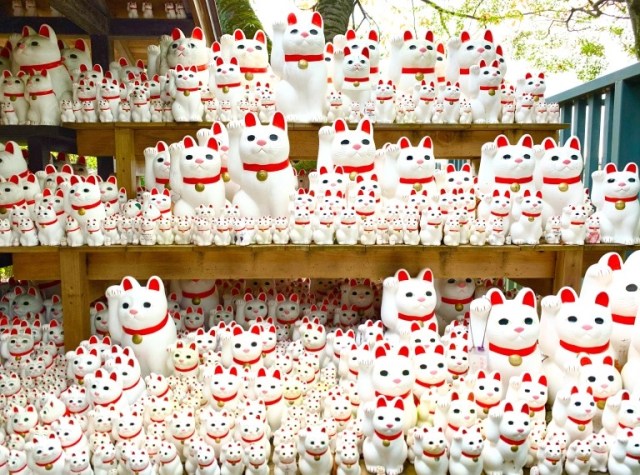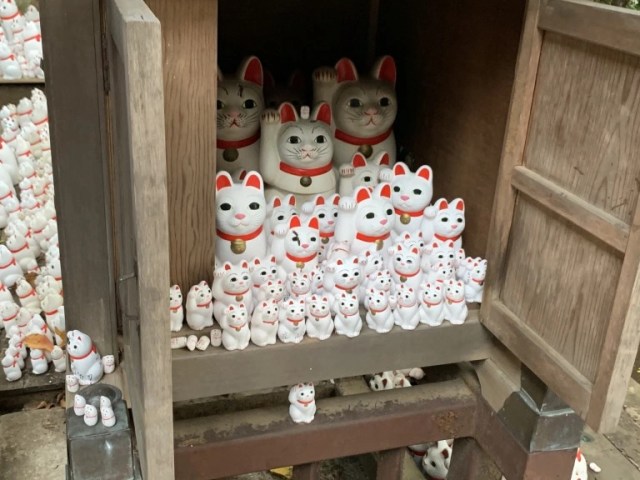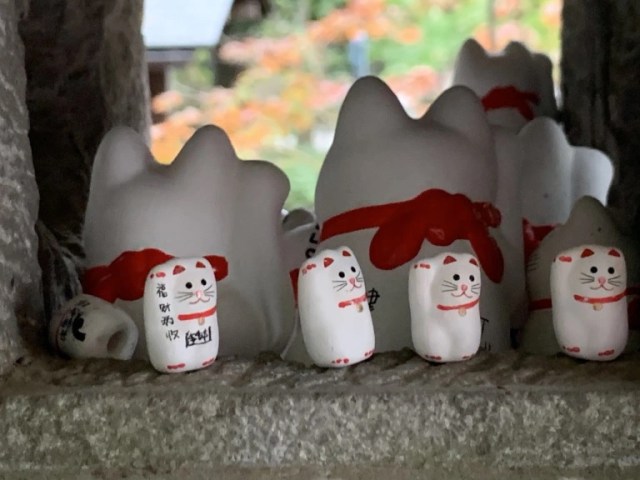Tokyo’s beckoning cat temple asks foreign tourists to stop writing on the beckoning cats they buy

Gotokuji claims the figurines are “sacred.”
Located in Tokyo’s Setagaya Ward, Gotokuji’s name translates to “temple of great virtue.” And sure, as a Buddhist temple, it is a place for the virtuous, but it’s also a place for cat lovers.
That’s because on any given day you can expect to see somewhere around 10,000 manekineko, or “beckoning cat,” figurines on display on the temple grounds.

Legend has it that 400 years ago, when a prominent samurai lord was traveling throuh the area, he became caught in a violet thunderstorm. Looking for refuge from the lightning that was beginning to fall, the samurai spotted a cat that beckoned to him. He followed it to Gotokuji, where the monks gave him shelter until the storm passed, and in gratitude the samurai became the temple’s providing patron thereafter.
That’s why, to this day, Gotokuji sells beckoning cat figurines in the temple’s store, and recently they’ve become a big hit with visiting foreign travelers, as seen in the news report here.
The temple no doubt appreciates the patronage. Each figurine sells for between 500 and 7,000 yen (approximately US$3.25 and US$45), depending on size, and the temple says it’s been selling up to 800 in a single day during the ongoing travel boom. However, there’s one thing the temple is less happy about, which is people writing wishes or other messages on the figures.
A woman visiting from Germany, seen at the point cued up in the video here, has written the name of her pet cat on the figurine, which she says she plans to leave at the temple as a wish for her pet’s continued health. Another figurine with a wish for health, written in Chinese, and one with various currency symbols, apparently in hopes of achieving economic prosperity, can also be seen.
The temple says it does not want people to do such things, and has now posted a multilingual written notice, saying:
“The cat figurines are sacred items. Please do not scribble on them.”
There are actually a few different unusual aspects to the situation. First, manekineko figurines aren’t usually thought of as sacred within Japanese culture. Yes, they’ve been seen as good luck symbols for hundreds of years, with the cat’s raised paw said to beckon customers to businesses or wellness and wealth to a household. Those purported powers, though, aren’t ascribed to any religious energy or divine authority.
Manekineko aren’t exclusive to Gotokuji, nor did they originate at the temple, so this isn’t a case of a once-sacred object having its air of divinity eroded. Manekineko are readily available in souvenir shops, and while they have the same quasi-supernatural image of any good luck charm, they’re generally seen by people in Japan as a secular one.
At the same time, it is unusual to write wishes on manekineko. Written wishes typically go on ema, wooden boards that are also commonly sold at temples and shrines in Japan, and which are supposed to be hung on a special rack on the temple/shrine grounds to boost their wish-granting powers. Manekineko, on the other hand, are meant to provide a broader, less specific sort of good luck.
▼ Ema

So saying “A manekineko is sacred, so don’t write on it” is kind of like saying “A rabbit’s foot is sacred, so don’t write on it.” It’s a stretch to call it sacred…but it’s also weird to write on it.
It’s also worth pointing out that while the behavior of foreign tourists is becoming a topic of increased public awareness as Japan sees record-breaking numbers of inbound international travelers, people writing on their manekineko at Gotokuji isn’t a phenomenon that only started in the post-pandemic travel boom. When we visited the temple in 2019, we saw a few figurines with written messages on them then too.

The temple’s “please don’t write on the manekineko” notice is also written in both English and Japanese, suggesting that the temple feels even locals could possibly use a reminder, as seen at the point in the video here.
Still, even if it’s not only foreigners writing on manekineko, the large number of foreign visitors the temple is getting these days means that even if a small percentage of them are writing on the figurines, there’re going to be enough to get noticed. With the temple having specifically asked that people not write on them, the polite thing to do is to comply with the request. And if the idea of a temple dictating what you can and can’t do with a secular object that you’ve purchased doesn’t sit right with you? Well, when we visited the temple, they told us that there aren’t any set rules as to whether or not you need to leave the figurine you purchased at the temple for your wish to come true. Taking it home with you provides the exact same boost to your good fortune, they told us, so if you feel like you absolutely have to write on it, it’s probably best to wait until you get home to do so.
Source: YouTube/ANNnewsCH
Ema photo: Pakutaso
All other photos ©SoraNews24
● Want to hear about SoraNews24’s latest articles as soon as they’re published? Follow us on Facebook and Twitter!
Credit:




0 comments: